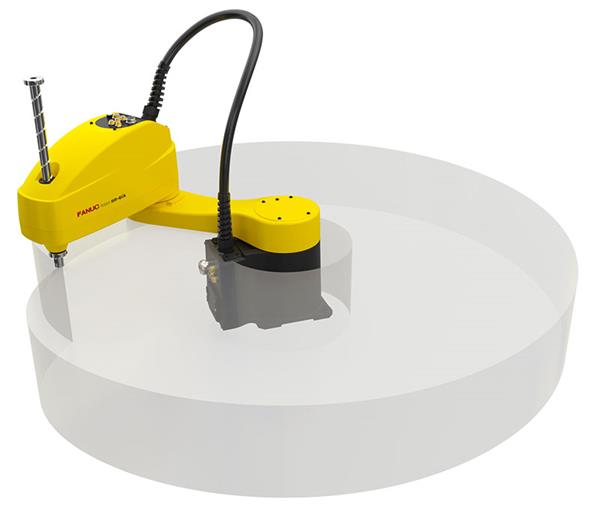SCARA robots are a popular option for small robotic assembly applications. SCARA is an acronym for Selective Compliance Articulated Robot Arm, meaning it is compliant in the X-Y axis, and rigid in the Z-axis. The SCARA configuration is unique and designed to handle a variety of material handling operations.
The SCARA’s structure consists of two arms joined at the base and the intersection of arms one and two. Two independent motors use inverse kinematics and interpolation at joints J1 and J2 to control the SCARA’s X-Y motion. The final X-Y location at the end of arm two is a factor of the J1 angle, J2 angle, length of arm one and length of arm two. (See FANUC SCARA Infographic)
There are several factors to consider when selecting the right robot for your application. Using this guideline will make the choice easier.
SCARA Robot - Articulation
Articulation is the type of motion and degrees of freedom required by the application. For a robot, the number of joints, joint location and the axis each joint controls determines its degree of freedom. SCARAs are four-axis robots, with motion in X-Y-Z and a rotational motion about the Z- axis.
A SCARA robot lacks the pitch and yaw motion of six-axis robots, so in applications where pitch and yaw is required, there are mechanisms that can be added to achieve the additional axis motion as long as the SCARA can accommodate payload requirements.
Most pick and place and small assembly applications that involve moving a part from point A to point B are perfect for SCARA robots because this typically involves relocating the part in X-Y-Z with some rotation in the Z-axis. Screw driving applications are also great for SCARA robots, where the rotation axis can easily drive screws. In addition, for robotic dispensing applications, a SCARA can pick parts and present them to a dispenser, or the dispensing tool can be attached to the robot’s shaft.
SCARA Robot - Work Envelope
The work envelope or the area of space that a robot can physically reach is a critical consideration. Whether SCARA, Delta Robots, or six-axis robots, the lengths of various links, and the limitations of the joint motion are important factors to review.
Typically, SCARA robots have a cylindrical shaped work envelope with variations in the diameter and depth of the cylinder. The total lengths of arms one and two define the diameter of the circle, while the Z stroke defines the depth of the cylinder. (See FANUC SCARA Work Envelope)

FANUC SR Series SCARA Robot Work Envelope
In most applications, a SCARA’s work envelope is contained to the front and side. The back area may not be useable if cables and pneumatic hoses exit from the rear - some SCARAs offer optional bottom exits – making it possible to work behind the robot.
SCARA Robot - Payload
In most applications, robots perform assembly or pick and place operations, which require an end-effector. It could be a simple gripper or a multi-purpose end-of-arm-tool with dispensers or screwdrivers.
The weight and inertia of the end-effector plus the part determines the maximum payload and inertia requirements, which must fall within the robot’s operating specifications.
Most robot manufacturers have at least two variants of SCARAs to accommodate different payloads and inertias. Understanding payload requirements is important - if a small robot can do the job, there’s no need to take up valuable floor space with a larger model.
SCARA Robot - Speed
Speed is an important factor when choosing a robot, and SCARAs are typically one of the fastest on the market. With four axes, they have less moving joints and are configured so that J1 and J2 control the X-Y motion, and J3 and J4 control the Z and rotation motion. This simplifies inverse kinematic calculations, requiring less computational time. When cycle time is critical, consider a SCARA solution.
SCARA Robot - Footprint
The footprint is the space where the SCARA robot mounts. Typically, SCARAs have a smaller footprint than Cartesian or Delta robots with the same reach. SCARA robots with larger work envelopes have larger footprints because of the increased motor and base sizes needed for stability.
SCARA Robot - Repeatability
SCARA robots typically have the best repeatability performance of all robot types. Errors that occur in the X-Y position are due to having two motors at J1 and J2. Other robot types have three or more motors contributing to the X-Y position. The more motors, the more likely errors could occur.
Excellent repeatability is crucial in small assembly applications where tolerances are required to be within several microns. Examples include inserting connectors into circuit boards or moving a needle into a small groove for dispensing.
SCARA robots have proven valuable for a variety of industries that manufacture parts requiring the highest possible accuracy and speed. Taking the time to work with a trusted robot supplier is the key to a successful SCARA application.
Click below to learn more about FANUC's New SR Series SCARA Robots, or contact us today to speak with a SCARA Robot application expert. We'll be happy to answer any questions you may have.
Contact A SCARA Expert FANUC SCARA Robots